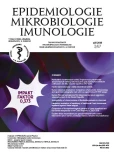Molecular characterization of Streptococcus pneumoniae isolates recovered from cases of pneumococcal vaccine failure in children under five years of age in the Czech Republic in 2012–2014
Authors:
Z. Okonji; J. Kozáková
Authors‘ workplace:
Centrum epidemiologie a mikrobiologie, Státní zdravotní ústav, Praha
Published in:
Epidemiol. Mikrobiol. Imunol. 67, 2018, č. 3, s. 99-103
Category:
Original Papers
Overview
Objective:
Molecular characterization of Streptococcus pneumoniae isolates recovered in the Czech Republic from previously vaccinated patients diagnosed with invasive pneumococcal disease caused by vaccine serotypes in 2012–2014. The target group were children under five years of age.
Material and methods:
S. pneumoniae strains are referred to the National Reference Laboratory for Streptococcal Infections (NRL) from all over the Czech Republic. Pneumococcal vaccine failure was identified based on the international definition. The NRL routinely performs identification and typing of isolates using both conventional and molecular methods. To characterize in more detail eight isolates from cases of pneumococcal vaccine failure, multilocus sequence typing (MLST) was used.
Results:
In 2012–2014, eight S. pneumoniae strains were recovered from children under five years of age diagnosed with vaccine failure. The strains were assigned to serotypes 1 (n = 4), 14 (n = 2), and 3 (n = 2). Serotype 1 isolates were of one sequence type, ST306, which is typical for serotype 1. Similarly, serotype 14 was exclusively of ST124, which is often linked to serotype 14 in the Czech Republic, although in other geographical areas, other STs are often found. Serotype 3 is highly heterogeneous, which is also reflected in multiple STs found in it. We identified a clonal complex comprising ST505 and ST124. ST124 is for the first time reported in S. pneumoniae of serotype 3 in the world.
Conclusion:
Results are presented of a pilot project conducted in the Czech Republic and focused on molecular characterization of S. pneumoniae strains recovered from cases of pneumococcal vaccine failure in children under five years of age. The data obtained are helpful in improving the surveillance of IPD in the Czech Republic.
KEYWORDS:
Streptococcus pneumoniae – vaccine failure – molecular surveillance – MLST
Sources
1. Vacková Z, Lžičařová D, Stock NK, Kozáková J. Real-time PCR detection of Neisseria meningitidis, Haemophilus influenzae, and Streptococcus pneumoniae DNA in clinical specimens. Epidemiol Mikrobiol Imunol, 2015;64(4):222–230.
2. Vacková Z, Klímová M, Kozáková J. Nová metoda a schéma typizace Streptococcus pneumoniae. Epidemiol Mikrobiol Imunol, 2013;62(2):10–18.
3. Mark C. Enright and Brian G. Spratt. A multilocus sequence typing scheme for Streptococcus pneumoniae: identification of clones associated with serious invasive disease. Microbiology, 1998;144 : 3049–3060.
4. https://pubmlst.org/spneumoniae/
5. Kozáková J, Vacková Z, Šebestová H, Křížová P. Invazivní pneumokokové onemocnění v České republice v roce 2016. Zprávy CEM (SZÚ, Praha), 2017;26(1):21–28.
6. Žemličková H, Urbášková P, Jakubů V, Motlová J, Musílek M, Procházka B. Clonal Distribution of Invasive Pneumococci, Czech Republic, 1996–2003. Emerging Infectious Diseases, 2010;16(2):287–289. doi:10.3201/eid1602.080535.
7. Žemličková H, Jakubů V, Urbášková P, Motlová J, Musílek M, Adámková V. Serotype-specific invasive disease potential of Streptococcus pneumoniae in Czech children. Journal of Medical Microbiology, 2010;59 : 1079–1083. doi: 10.1017/S09502688-06006157.
8. Zhou H, Guo J, Qin T, Ren H, Xu Y, Wang C, Xu X. Serotype and MLST-based inference of population structure of clinical Streptococcus pneumoniae from invasive and noninvasive pneumococcal disease. Infection Genetics and Evolution, 2017;55 : 104–111. doi: 10.1016/j.meegid.2017.08.034.
9. Slotved HC, Dalby T, Hoffmann S. Multilocus sequence types of invasive pneumococcal isolates from Danish infants (0–90 days) 2003–2013. BMC Res Notes, 2015;8 : 563. doi: 10.1186/s13104-015-1540-y.
10. Guldemir D, Acar S, Otgun SN, Unaldi O, Gozalan A, Ertek M, Durmaz R. Invasive Pneumococcal Diseases Study Group. High-Level Genetic Diversity among Invasive Streptococcus pneumoniae Isolates in Turkey. Jpn J Infect Dis, 2016;69(3):207–212. doi: 10.7883/yoken.JJID.2015.062.
11. Muñoz-Almagro C, Ciruela P, Esteva C, Marco F, Navarro M, Bartolome R, Sauca G, Gallés C, Morta M, Ballester F, Raga X, Selva L. Catalan study group of invasive pneumococcal disease. Serotypes and clones causing invasive pneumococcal disease before the use of new conjugate vaccines in Catalonia, Spain. J Infect, 2011;63(2):151–162. doi: 10.1016/j.jinf.2011.06.002.
12. Del Amo E, Esteva C, Hernandez-Bou S, Galles C, Navarro M, Sauca G, Diaz A, Gassiot P, Marti C, Larrosa N, Ciruela P, Jane M, Sá-Leão R, Muñoz-Almagro C. Catalan Study Group of Invasive Pneumococcal Disease. Serotypes and Clonal Diversity of Streptococcus pneumoniae Causing Invasive Disease in the Era of PCV13 in Catalonia, Spain. PLoS One, 2016,11(3):e0151125. doi: 10.1371/journal.pone.0151125.
13. Jefferies JM, Smith A, Clarke SC, Dowson C, Mitchell TJ. Genetic Analysis of Diverse Disease-Causing Pneumococci Indicates High Levels of Diversity within Serotypes and Capsule Switching. J Clin Microbiol, 2004;42(12):5681–5688. doi: 10.1128/JCM.42.12.5681-5688.2004.
14. Ladhani SN, Slack MP, Andrews NJ, Waight PA, Borrow R, Miller E. Invasive pneumococcal disease after routine pneumococcal conjugate vaccination in children, England and Wales. Emerg Infect Dis, 2013;19(1):61–68. doi: 10.3201/eid1901.120741.
Labels
Hygiene and epidemiology Medical virology Clinical microbiologyArticle was published in
Epidemiology, Microbiology, Immunology

2018 Issue 3
Most read in this issue
- Comparison of the epidemiological patterns of Lyme borreliosis and tick-borne encephalitis in the Czech Republic in 2007–2016
- Fecal bacteriotherapy in the treatment of Clostridium difficile infection
- Successful rituximab treatment of granulomatous/lymphocytic interstitial lung disease in common variable immunodeficiency
- Susceptibility of clinical isolates of Bordetella pertussis to chemicals
